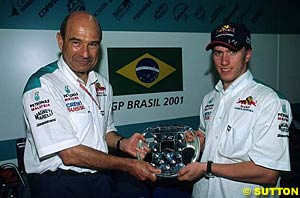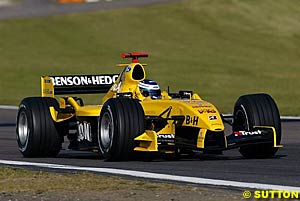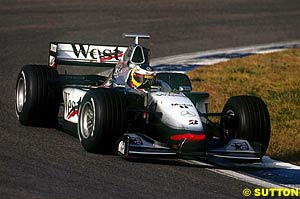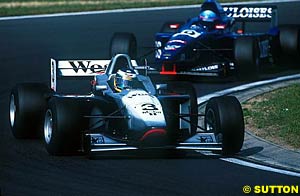
Atlas F1 Magazine Writer
Since making his Formula One debut in 2000, Nick Heidfeld has been waiting. Five seasons in Grand Prix racing have left the highly-rated German without a competitive drive, and with no equipment to prove his worth. His test with the Williams team this week could be the opportunity he has been hoping for: if all goes well, Nick Heidfeld could finally show what he's capable of. Atlas F1's Dieter Rencken interviewed Heidfeld earlier this week and offers a profile of the modest driver, while Ross Stonefeld recaps Heidfeld's F3000 championship season
Heidfeld knows that impressing Williams represents his only realistic chance of succeeding in the formula he has had his eye on since that first drive at the Nurburgring's karting centre in 1985. Nick had been grounded from Moto-X following severe injury to leg muscle after falling off the machine he had received as a Christmas present three years before, and motorsport mad Papa Wolfgang, now marketing Monaco Grand Prix accommodation and hospitality packages, had decided on four wheels as being the safer option.
"My father had raced karts and used to take us on fast laps around the Nordschleife, and when the karting centre there opened, he took us three boys along." Nick's younger brother Sven has, in the interim, become an accomplished F3000 driver. "He instructed us to do some slow laps behind him, but after one round I decided that he was too slow, so I overtook him, and that was that..."
Eight-year old Nick set his sights firmly upon Formula One then, and never considered any other career option. "Of course, I did not know about Formula Ford or Three or any other form of racing, but it was clear to me that racing was what I wanted, and for 1988 we bought some karts and raced first locally, then nationally."
The kart club then joined by Heidfeld was the Kerpen-Manheim club, which boasts as former members Michael and Ralf Schumacher, and Heinz-Harald Frentzen, whilst fellow German Grand Prix winner, Graf Berghe Wolfgang von Trips, also hails from the flat Nordrhein Westfallen region. The fifth member of the country's victory club, Jochen Mass, hails from Munich.
"It was very much a family affair, with my father and brothers acting as mechanics for me when I raced, and me for them on their turns. But it was incredible fun, and we won some German championships, which I think was very good for a family team without any real support. We raced in Germany and Holland - I was born in Moenchengladbach, very close to the Dutch border - and eventually we made it to the 1992 Class A world championships. But, a private team can not hope to compete against the professionals like Tonykart, so I was happy just to be there. Then we sold up the karting stuff and bought a used Formula Ford for 1994."
Heidfeld won the 1600cc class in Germany's Formula Ford championship, winning all but one of the series' nine races, and took in the World Final at Brands Hatch, where he laid second until crashing. The following year saw him regrouping in two 1800 categories, winning the International German Championship, and taking second in the national championship. Of greater significance was the appointment of manager Werner Heinz, who, to this day, manages the slightly-built (1,64m; 59kg), Swiss-domiciled driver.
"More importantly, though," Heidfeld continues, "we made contact with Mercedes-Benz, and they agreed to sponsor my season with Opel Team BSR, and the car was painted silver and black, resembling a mini McLaren-Mercedes."
But, the deal was more than just paint deep: he was signed by McLaren as tester on a long-term option, and became the first driver to develop grooved, narrow tyres in preparation for regulations to be introduced from 1998.
"I tested Goodyears for them all season, and, in fact, only one run, my first test, on wide tyres; thereafter I only drove on grooved tyres. In total I ran 5,000 kilometres, and it was invaluable experience which prepared me for the next step - F3000."
McLaren formed the West Competition team for the feeder category, and Heidfeld went into the last round with a grip on the championship. Alas, it was not to be: the team inadvertently used contaminated fuel, and the title-hopeful was relegated to the back of the grid for the deciding race. But, it was, he says, a very enjoyable season.
"We built the team up from scratch, and we fought hard against (Juan Pablo) Montoya all season long. People say 'Yes, but it was a McLaren team', but that does not address the issue of building a team from nothing and going all the way to the last race. We lost, but through no fault of my own, and it was really a hard season. I enjoyed fighting against Montoya immensely, and it was a more satisfying season than the following year, which we won easily." It's typical that Heidfeld, again somewhat modest, relates to overcoming the largest ever F3000 grid as an easy win, but more on that in the sidebar below.
Prost Grand Prix beckoned in 2000, and Heidfeld is frank about that disappointing phase of his career. All his racing life he had aimed for F1, for three years he had tested amongst the best cars in the Championship, pre-season testing indicated that the quadruple champion's outfit had a strong package, but then, come the end of a long dry season, the Prost-Peugeot officially finished as worst team - behind Minardi. The nadir was disqualification from qualifying at his home race at the Nurburgring, and even a single high point impossible to find.
But, come contract time, Ron Dennis somewhat inexplicably chose the Finn over the German, still under contract to McLaren-Mercedes at that stage, when it came to replacing a listless Mika Hakkinen.
"Of course I was disappointed by that," explains Heidfeld. "I read in the media that I threw tantrums and all that, but it simply was not true. I could not understand it as I was still under option to McLaren for another two years, but I had to accept it. What else could I do? I just vowed to do the best I could in future."
2002 saw Sauber slip to fifth in the standings, but, yet again, Nick finished ahead of his teammate, in this case Felipe Massa, in F1's critical ratings. In his final Sauber season, in 2003, Heidfeld outqualified Heinz-Harald Frentzen, no mean slouch, 10:7, and was well on course for a podium during Indianapolis's rain lottery.
But, as in 2001, circumstances forced him to inwardly beg what else was needed to maintain a presence, any presence on the Grand Prix grid. Although Heidfeld won't expand, it seems Peter Sauber owed Massa a race return after a year's Ferrari testing, and, with Giancarlo Fisichella signed, Nick had nowhere to go but out of Sauber. Eddie Jordan made a tentative offer, one which nipped-and-tucked all the way to Melbourne, and only once in Australia was Heidfeld secure in a yellow seat. Even there, though, rumours did the rounds that Jos Verstappen's Trust sponsor was wedging a return for the Dutchman, who had previously fallen out with EJ.
Whatever, Heidfeld put his head up and foot down, and, despite running a car considered by some the worst of the lot, he ran some magical laps which strung together to deliver placings way ahead of the Ford-funded-Cosworth-powered EJ14's. On Saturdays, too, he was most impressive, although his qualifying pace was often masked by fuel load factors, so did not raise as many eyebrows.
Is this a pointed reference to his displacement? "No, not at all. (Long-time girlfriend) Patricia and I live in Stafa on the shores of Lake Zurich, which is close to the Sauber factory, and I have always got on well with the guys there. But it is a fact that Jordan had the same tyres, and less performance, yet Massa and I raced nose-to-tail to the line at the European Grand Prix." It had been, though, another long season for Nick, and, in Brazil one sensed he was looking forward to packing away his Yellows.
So, on to Williams. Of course, he accepts that 'Buttongate' played a crucial part in him being granted the opportunity of testing the blue/white cars, with BAR-Honda creating even earlier opportunities by disallowing Anthony Davidson's evaluation programme. But, equally, this wannabe Williams driver realises that he not only needs to blow off Antonio Pizzonia, who has a firm grasp on the wheel of the team's second entry Williams by virtue of being resident tester, but also to impress the battle-hardened trio of Sir Frank Williams, Patrick Head and Sam Michael.
That, though, Heidfeld seems to have done, for despite originally being scheduled to test only this week (8-12 December), the Davidson saga led to an early invite. Heavy rain hampered testing proceedings at Jerez in southern Spain, and, despite never having driven the car before nor having experience on Michelins, Heidfeld ended quicker than Pizzonia. Not surprisingly, Williams requested further evaluation - speaking volumes for the driver, who, until a week ago, was reckoned to be no more than an outsider for the team, despite their close partnership with German engine supplier BMW.
Crucially, Heidfeld proved a rapid but safe pair of hands - qualities Sir Frank admires - but laments that conditions made it impossible to run at the max. "It is a pity we had no real dry running, which made it impossible to feel the outright speed of the Williams/BMW/Michelin combination, but already I can tell it is the best team I have ever worked with."
Heidfeld: "I can definitely say that Williams is operating at a higher level now than McLaren was then, and I was very impressed with the BMW engine, which is very powerful and tractable across the whole rev range."
DR: What about Michelin?
Heidfeld: "We tested in all conditions last week. Although it was mainly wet, we also used intermediates and dries when the conditions allowed, and my first impressions are of very good, consistent grip."
Heidfeld has proven that he can win; after all, he has won in every category before F1, in the process beating the likes of Montoya and Jarno Trulli, both of whom have since joined that hallowed list of Grand Prix victors. But, can he win in F1? "Given the right equipment, I really don't see why not," he says bluntly.
His response takes me back to where we began: he did not have the tools to win karting world championships, so he never did and is honest enough to correct any possible misconceptions in this regard. Once, though, given the right stuff in Formula Ford, F3 and F3000 he delivered, and how. So, right now he is mustering his all to ensure that Williams and BMW choose him over the Amazon's Antonio Pizzonia.
And, if they don't? "I am not even thinking along those lines. I am a Formula One driver..."
By Ross Stonefeld, Italy
Much has been made Formula 3000 Champion Vitantonio Liuzzi's record results in 2004, but they pale in comparison to the depth of Nick Heidfeld's 1999 achievement.
Just 21 years of age at the first round of the season, Heidfeld had it all to lose. Following his championships in Formula Ford and Formula Three, he had made a stunning debut in 1998 with West Competition, taking the fight to Juan Pablo Montoya and Super Nova all season long, finishing a close second and showing he was the match for the astronomical Montoya both in outright speed but also racecraft. If Heidfeld couldn't take the '99 championship, he would not only dilute the momentum his career had built thus far, but he'd be hard pressed to regain it, with the CART series being the only other option if he could not graduate to F1.
The season would be contested over 10 rounds, all supporting Formula One Grands Prix and the allure of high profile weekends and sealed, spec racing attracted the best and brightest from the world's junior formulae. By season's end, 54 drivers would attempt to qualify for an F3000 race, with 23 scoring a championship point. The grid included six national Formula Three champions as well as five Formula One "Junior Teams" and an additional two with sponsorship links to their bigger brothers.
In the opening round at Imola, 42 cars showed up to qualify for 26 grid slots. In that race, as was the case all season long; the field was split into two groups with the fastest 13 from each making the final grid. At the end of the 45-minute session Brazilian Max Wilson of the Petrobras Williams Junior Team took pole. Heidfeld was second in his group and third overall, just 0.097 seconds behind Wilson. 1.521 seconds off pole was Norman Simon, 26th and last; the cut-off point between those who drove hard, and those who would simply drive home.
At the lights Heidfeld maintained his third place, passing Nordic's Kevin McGarrity on lap 10 and leader Max Wilson on lap 21 in a move that left the Brazilian in the gravel and out of the race. McGarrity held second from Fabrice Walfisch but would finish 22 seconds behind Heidfeld.
The next round was at Monte Carlo and having won there in Formula Three in 1997 and 1998 in the inaugural F3000 race, Heidfeld was again the favorite and responded with pole. He led comfortably before he was given a stop-go penalty for jumping the start and was able to respond with a seventh place finish, which under the old scoring system meant no points for his troubles. Victory went to Gonzalo Rodriguez of Uruguay in the Benetton affiliated Team Astromega entry.
Heidfeld's motivation and speed showed no loss in the next two events as he was fastest in qualifying and took wins at Barcelona and in the wet round at Magny Cours. Nicolas Minassian won for debut team Kid Jensen Racing at Silverstone, with Petrobras' fast improving Bruno Junqueira second and Heidfeld in third, maintaining his points lead.
The hat trick of pole, fast lap, and victory went again to Heidfeld at the A-1 Ring and was then well clear in the points on 44, with Gonzalo Rodriguez second on 18, Minassian on 14 and Bruno Junqueira on just 10. Heidfeld was in a position to clinch the title on home soil at the old Hockenheim, but the Petrobras Williams team were determined to stay in the championship, sweeping the front row with Wilson and Junqueira, the first time a team had done so since 1993.
Heidfeld's DNF was not the disaster it could have been as title challenger Gonzalo Rodriguez was only able to make up three points on Heidfeld's massive lead, with only three rounds remaining. Heidfeld went into championship mode in Hungary, finishing second to Stephane Sarrazin to take the series' crown and soon announce his 2000 drive for Gauloises Prost-Peugeot.
Perhaps overconfident as the new champion, at Spa he could only qualify 10th but even with that his worst result of the season, he would end the year with an average grid spot of third against a grid where only seven drivers of 54 managed to qualify for every race.
To reaffirm his place at the front of the series he fought his way to fourth in Belgium and duly took pole in the season finale at the Nurburgring, finishing second to Jason Watt. The weekend was on a somber note as the F3000 paddock reacted to the death of highly popular driver Gonzalo Rodriguez in practice for the CART race at Laguna Seca. He would lose his second place in the points to Denmark's Watt, who was paralysed in a motorcycle accident shortly after the end of the season.
Final Results, 1999 FIA Formula 3000
Nick Heidfeld gently corrects me. "My karting career was not as illustrious as you have just made it out; sure, I am very proud of what I achieved, but I didn't win a really major or world title." This refreshing honesty hallmarked the entire interview with the German - just 27 despite five Formula One seasons behind him - who was still reflecting on the trials and tribulations presented by a crucial test with Williams on a streaming Jerez circuit last week.
 Heidfeld arrived at the test as the dark horse for the second seat, alongside Australian Mark Webber. After two days of testing in the wet, the team invited him for a second test session, this week, and suddenly he seems to be within real chance of landing the drive. In fact, Red Bull sources revealed this week that Heidfeld had a standing offer to test for them but he had not followed it up - an indication that he saw his future elsewhere.
Heidfeld arrived at the test as the dark horse for the second seat, alongside Australian Mark Webber. After two days of testing in the wet, the team invited him for a second test session, this week, and suddenly he seems to be within real chance of landing the drive. In fact, Red Bull sources revealed this week that Heidfeld had a standing offer to test for them but he had not followed it up - an indication that he saw his future elsewhere.
 Formula Three with Bertram Schaefer Racing followed: 1996 saw Heidfeld take third in the German championship - won by Jarno Trulli - but Nick had the satisfaction of taking pole at Macau, and winning the first heat. The second saw him spin to avoid a crasher, and he finished sixth overall. The following year he stayed in the category, but stepped up his performance all round, winning his national title and the prestigious Monaco Grand Prix.
Formula Three with Bertram Schaefer Racing followed: 1996 saw Heidfeld take third in the German championship - won by Jarno Trulli - but Nick had the satisfaction of taking pole at Macau, and winning the first heat. The second saw him spin to avoid a crasher, and he finished sixth overall. The following year he stayed in the category, but stepped up his performance all round, winning his national title and the prestigious Monaco Grand Prix.
 Peter Sauber, though, threw Heidfeld a lifeline, and he immediately rewarded the Swiss team with a podium via a fine third at Interlagos. The sight of Nick in the blue/turquoise overalls of Sauber became a regular one over the next three years; more importantly, though, that first season brought him head-to-head with Kimi Raikkonen. He was unfazed by the monosyllabic Finn's raw speed, did not let the hype surrounding his teammate get to him, and Heidfeld ended the season up on Raikkonen in all benchmarks: podiums (1:0), qualifying positions (10:7), Championship standings (7th:10th) and points (12:9). Between them, they helped Sauber to fourth - the team's best-ever championship standing and headed only by Ferrari, McLaren and Williams.
Peter Sauber, though, threw Heidfeld a lifeline, and he immediately rewarded the Swiss team with a podium via a fine third at Interlagos. The sight of Nick in the blue/turquoise overalls of Sauber became a regular one over the next three years; more importantly, though, that first season brought him head-to-head with Kimi Raikkonen. He was unfazed by the monosyllabic Finn's raw speed, did not let the hype surrounding his teammate get to him, and Heidfeld ended the season up on Raikkonen in all benchmarks: podiums (1:0), qualifying positions (10:7), Championship standings (7th:10th) and points (12:9). Between them, they helped Sauber to fourth - the team's best-ever championship standing and headed only by Ferrari, McLaren and Williams.
 "I knew that the car did not have as much power as the Ferraris we used at Sauber, even when they were a year older - or two really, as Sauber used to get one-year old engines from Ferrari at that stage - but we really worked well together," Heidfeld says of Jordan. He uses the European Grand Prix, at which his fastest race lap was 0.6 seconds quicker than Massa's Sauber, on the same tyres, as example. "Considering the performance differences between the cars, we did well to race to the line nose-to-tail with Felipe, and it was only after the effects of Sauber's new wind tunnel came into play that they pulled away from us in the second half of the season."
"I knew that the car did not have as much power as the Ferraris we used at Sauber, even when they were a year older - or two really, as Sauber used to get one-year old engines from Ferrari at that stage - but we really worked well together," Heidfeld says of Jordan. He uses the European Grand Prix, at which his fastest race lap was 0.6 seconds quicker than Massa's Sauber, on the same tyres, as example. "Considering the performance differences between the cars, we did well to race to the line nose-to-tail with Felipe, and it was only after the effects of Sauber's new wind tunnel came into play that they pulled away from us in the second half of the season."
 DR: Better than McLaren? You tested for them during the years they won two Drivers' and one Constructors' Championships
DR: Better than McLaren? You tested for them during the years they won two Drivers' and one Constructors' Championships
Sidebar: The Best F3000 Champion
 If expectations weren't high enough, Heidfeld had to overcome a new car design and what became the largest F3000 championship in its history, and arguably one of the most difficult championships racing history has seen.
If expectations weren't high enough, Heidfeld had to overcome a new car design and what became the largest F3000 championship in its history, and arguably one of the most difficult championships racing history has seen.
 Heidfeld ran with his upper rear wing element removed for an ultra-low downforce package that put him fifth on the grid. It paid dividends in the race as Heidfeld was immediately challenging leader Max Wilson, but the German made a rare mistake in the Ostkurve and was out of the race. Wilson did not have clear sailing as teammate Junqueira recovered from a poor opening lap to later pass him and claim his first F3000 victory.
Heidfeld ran with his upper rear wing element removed for an ultra-low downforce package that put him fifth on the grid. It paid dividends in the race as Heidfeld was immediately challenging leader Max Wilson, but the German made a rare mistake in the Ostkurve and was out of the race. Wilson did not have clear sailing as teammate Junqueira recovered from a poor opening lap to later pass him and claim his first F3000 victory.
1. Nick Heidfeld - West Competition 59
2. Jason Watt - Super Nova 30
3. Gonzalo Rodriguez - Team Astromega 27
4. Stephane Sarrazin - Gauloises Formula 22
5. Bruno Junqueira - Petrobras Junior Team 20
=. Nicolas Minassian - Kid Jensen Racing 20
|
Contact the Author Contact the Editor |
Please Contact Us for permission to republish this or any other material from Atlas F1.
|
Volume 10, Issue 49
Interview with Nick Heidfeld
Interview with Williams Technical Chiefs
Bookworm Critique
On the Road
Elsewhere in Racing
The Weekly Grapevine
> Homepage |